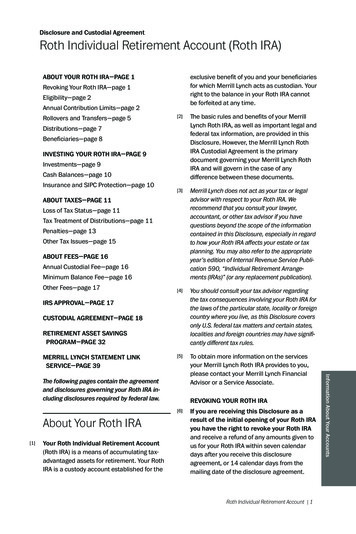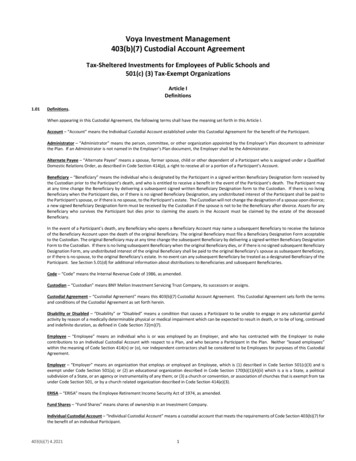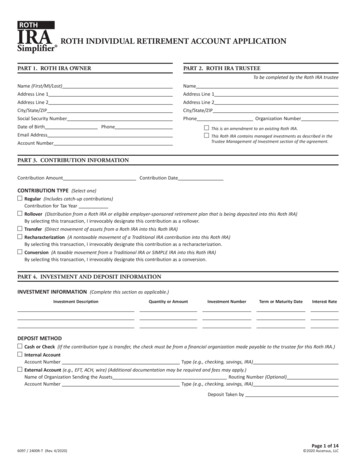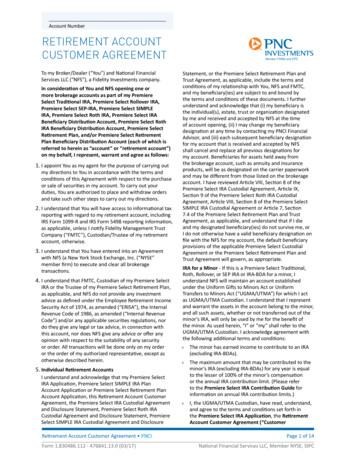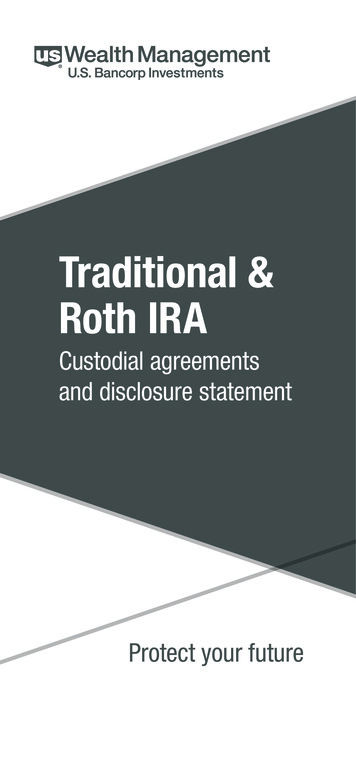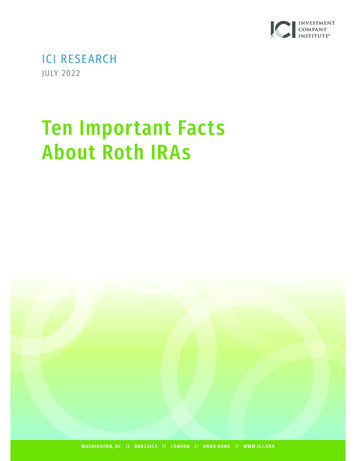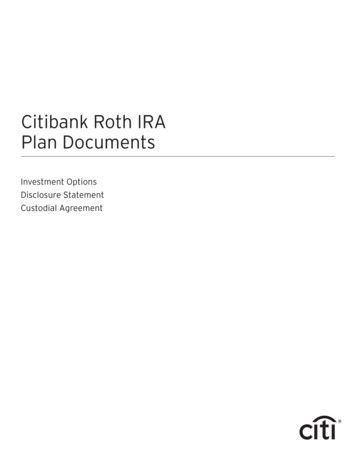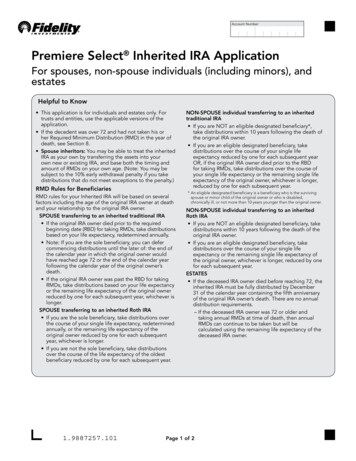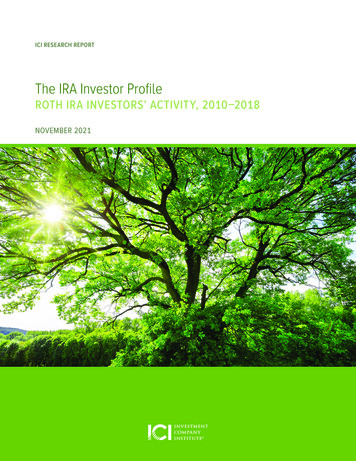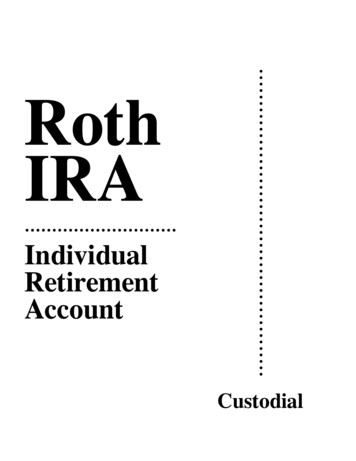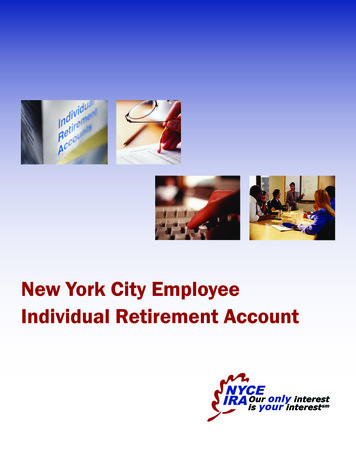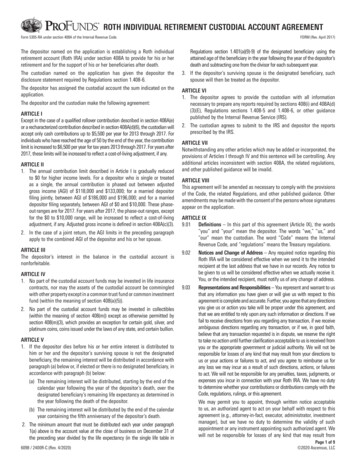
Transcription
ROTH INDIVIDUAL RETIREMENT CUSTODIAL ACCOUNT AGREEMENTForm 5305-RA under section 408A of the Internal Revenue Code.The depositor named on the application is establishing a Roth individualretirement account (Roth IRA) under section 408A to provide for his or herretirement and for the support of his or her beneficiaries after death.The custodian named on the application has given the depositor thedisclosure statement required by Regulations section 1.408-6.The depositor has assigned the custodial account the sum indicated on theapplication.The depositor and the custodian make the following agreement:ARTICLE IExcept in the case of a qualified rollover contribution described in section 408A(e)or a recharacterized contribution described in section 408A(d)(6), the custodian willaccept only cash contributions up to 5,500 per year for 2013 through 2017. Forindividuals who have reached the age of 50 by the end of the year, the contributionlimit is increased to 6,500 per year for tax years 2013 through 2017. For years after2017, these limits will be increased to reflect a cost-of-living adjustment, if any.ARTICLE II1. The annual contribution limit described in Article I is gradually reducedto 0 for higher income levels. For a depositor who is single or treatedas a single, the annual contribution is phased out between adjustedgross income (AGI) of 118,000 and 133,000; for a married depositorfiling jointly, between AGI of 186,000 and 196,000; and for a marrieddepositor filing separately, between AGI of 0 and 10,000. These phaseout ranges are for 2017. For years after 2017, the phase-out ranges, exceptfor the 0 to 10,000 range, will be increased to reflect a cost-of-livingadjustment, if any. Adjusted gross income is defined in section 408A(c)(3).2. In the case of a joint return, the AGI limits in the preceding paragraphapply to the combined AGI of the depositor and his or her spouse.ARTICLE IIIThe depositor’s interest in the balance in the custodial account isnonforfeitable.ARTICLE IV1. No part of the custodial account funds may be invested in life insurancecontracts, nor may the assets of the custodial account be commingledwith other property except in a common trust fund or common investmentfund (within the meaning of section 408(a)(5)).2. No part of the custodial account funds may be invested in collectibles(within the meaning of section 408(m)) except as otherwise permitted bysection 408(m)(3), which provides an exception for certain gold, silver, andplatinum coins, coins issued under the laws of any state, and certain bullion.ARTICLE V1. If the depositor dies before his or her entire interest is distributed tohim or her and the depositor’s surviving spouse is not the designatedbeneficiary, the remaining interest will be distributed in accordance withparagraph (a) below or, if elected or there is no designated beneficiary, inaccordance with paragraph (b) below:(a) The remaining interest will be distributed, starting by the end of thecalendar year following the year of the depositor’s death, over thedesignated beneficiary’s remaining life expectancy as determined inthe year following the death of the depositor.(b) The remaining interest will be distributed by the end of the calendaryear containing the fifth anniversary of the depositor’s death.2. The minimum amount that must be distributed each year under paragraph1(a) above is the account value at the close of business on December 31 ofthe preceding year divided by the life expectancy (in the single life table in6098 / 2400R-C (Rev. 4/2020)FORM (Rev. April 2017)Regulations section 1.401(a)(9)-9) of the designated beneficiary using theattained age of the beneficiary in the year following the year of the depositor’sdeath and subtracting one from the divisor for each subsequent year.3. If the depositor’s surviving spouse is the designated beneficiary, suchspouse will then be treated as the depositor.ARTICLE VI1. The depositor agrees to provide the custodian with all informationnecessary to prepare any reports required by sections 408(i) and 408A(d)(3)(E), Regulations sections 1.408-5 and 1.408-6, or other guidancepublished by the Internal Revenue Service (IRS).2. The custodian agrees to submit to the IRS and depositor the reportsprescribed by the IRS.ARTICLE VIINotwithstanding any other articles which may be added or incorporated, theprovisions of Articles I through IV and this sentence will be controlling. Anyadditional articles inconsistent with section 408A, the related regulations,and other published guidance will be invalid.ARTICLE VIIIThis agreement will be amended as necessary to comply with the provisionsof the Code, the related Regulations, and other published guidance. Otheramendments may be made with the consent of the persons whose signaturesappear on the application.ARTICLE IX9.01 Definitions – In this part of this agreement (Article IX), the words“you” and “your” mean the depositor. The words “we,” “us,” and“our” mean the custodian. The word “Code” means the InternalRevenue Code, and “regulations” means the Treasury regulations.9.02 Notices and Change of Address – Any required notice regarding thisRoth IRA will be considered effective when we send it to the intendedrecipient at the last address that we have in our records. Any notice tobe given to us will be considered effective when we actually receive it.You, or the intended recipient, must notify us of any change of address.9.03 Representations and Responsibilities – You represent and warrant to usthat any information you have given or will give us with respect to thisagreement is complete and accurate. Further, you agree that any directionsyou give us or action you take will be proper under this agreement, andthat we are entitled to rely upon any such information or directions. If wefail to receive directions from you regarding any transaction, if we receiveambiguous directions regarding any transaction, or if we, in good faith,believe that any transaction requested is in dispute, we reserve the rightto take no action until further clarification acceptable to us is received fromyou or the appropriate government or judicial authority. We will not beresponsible for losses of any kind that may result from your directions tous or your actions or failures to act, and you agree to reimburse us forany loss we may incur as a result of such directions, actions, or failuresto act. We will not be responsible for any penalties, taxes, judgments, orexpenses you incur in connection with your Roth IRA. We have no dutyto determine whether your contributions or distributions comply with theCode, regulations, rulings, or this agreement.We may permit you to appoint, through written notice acceptableto us, an authorized agent to act on your behalf with respect to thisagreement (e.g., attorney-in-fact, executor, administrator, investmentmanager), but we have no duty to determine the validity of suchappointment or any instrument appointing such authorized agent. Wewill not be responsible for losses of any kind that may result fromPage 1 of 9 2020 Ascensus, LLC
9.049.059.06directions, actions, or failures to act by your authorized agent, and youagree to reimburse us for any loss we may incur as a result of suchdirections, actions, or failures to act by your authorized agent.You will have 60 days after you receive any documents, statements,or other information from us to notify us in writing of any errors orinaccuracies reflected in these documents, statements, or otherinformation. If you do not notify us within 60 days, the documents,statements, or other information will be deemed correct and accurate,and we will have no further liability or obligation for such documents,statements, other information, or the transactions described therein.By performing services under this agreement we are acting as youragent. You acknowledge and agree that nothing in this agreementwill be construed as conferring fiduciary status upon us. We willnot be required to perform any additional services unless specificallyagreed to under the terms and conditions of this agreement, or asrequired under the Code and the regulations promulgated thereunderwith respect to Roth IRAs. You agree to indemnify and hold usharmless for any and all claims, actions, proceedings, damages,judgments, liabilities, costs, and expenses, including attorney’s feesarising from or in connection with this agreement.To the extent written instructions or notices are required under thisagreement, we may accept or provide such information in any otherform permitted by the Code or applicable regulations including, butnot limited to, electronic communication.Disclosure of Account Information – We may use agents and/or subcontractors to assist in administering your Roth IRA. We mayrelease nonpublic personal information regarding your Roth IRA tosuch providers as necessary to provide the products and services madeavailable under this agreement, and to evaluate our business operationsand analyze potential product, service, or process improvements.Service Fees – We have the right to charge an annual service feeor other designated fees (e.g., a transfer, rollover, or termination fee)for maintaining your Roth IRA. In addition, we have the right to bereimbursed for all reasonable expenses, including legal expenses, weincur in connection with the administration of your Roth IRA. We maycharge you separately for any fees or expenses, or we may deductthe amount of the fees or expenses from the assets in your Roth IRAat our discretion. We reserve the right to charge any additional feeafter giving you 30 days’ notice. Fees such as subtransfer agent feesor commissions may be paid to us by third parties for assistance inperforming certain transactions with respect to this Roth IRA.Any brokerage commissions attributable to the assets in your RothIRA will be charged to your Roth IRA. You cannot reimburse yourRoth IRA for those commissions.Investment of Amounts in the Roth IRA – You have exclusiveresponsibility for and control over the investment of the assets of yourRoth IRA. All transactions will be subject to any and all restrictions orlimitations, direct or indirect, that are imposed by our charter, articlesof incorporation, or bylaws; any and all applicable federal and statelaws and regulations; the rules, regulations, customs and usages of anyexchange, market or clearing house where the transaction is executed;our policies and practices; and this agreement. After your death, yourbeneficiaries will have the right to direct the investment of your Roth IRAassets, subject to the same conditions that applied to you during yourlifetime under this agreement (including, without limitation, Section9.03 of this article). We will have no discretion to direct any investmentin your Roth IRA. We assume no responsibility for rendering investmentadvice with respect to your Roth IRA, nor will we offer any opinion orjudgment to you on matters concerning the value or suitability of anyinvestment or proposed investment for your Roth IRA. In the absence ofinstructions from you, or if your instructions are not in a form acceptableto us, we will have the right to hold any uninvested amounts in cash,6098 / 2400R-C (Rev. 4/2020)9.079.08and we will have no responsibility to invest uninvested cash unless anduntil directed by you. We will not exercise the voting rights and othershareholder rights with respect to investments in your Roth IRA unlessyou provide timely written directions acceptable to us.You will select the investment for your Roth IRA assets fromthose investments that we are authorized by our charter, articlesof incorporation, or bylaws to offer and do in fact offer for RothIRAs (e.g., term share accounts, passbook accounts, certificates ofdeposit, money market accounts.)Beneficiaries – If you die before you receive all of the amounts in yourRoth IRA, payments from your Roth IRA will be made to your beneficiaries.We have no obligation to pay to your beneficiaries until such time we arenotified of your death by receiving a valid death certificate.You may designate one or more persons or entities as beneficiary ofyour Roth IRA. This designation can only be made on a form providedby or acceptable to us, and it will only be effective when it is filed withus during your lifetime. Each beneficiary designation you file with uswill cancel all previous designations. The consent of your beneficiarieswill not be required for you to revoke a beneficiary designation. Ifyou have designated both primary and contingent beneficiaries andno primary beneficiary survives you, the contingent beneficiaries willacquire the designated share of your Roth IRA. If you do not designatea beneficiary or if all of your primary and contingent beneficiariespredecease you, your estate will be the beneficiary.If your surviving spouse is the designated beneficiary, your spouse mayelect to treat your Roth IRA as his or her own Roth IRA, and would notbe subject to the required minimum distribution rules. Your survivingspouse will also be entitled to such additional beneficiary paymentoptions as are granted under the Code or applicable regulations.We may allow, if permitted by state law, an original Roth IRA beneficiary(the beneficiary who is entitled to receive distributions from an inheritedRoth IRA at the time of your death) to name successor beneficiaries forthe inherited Roth IRA. This designation can only be made on a formprovided by or acceptable to us, and it will only be effective when it isfiled with us during the original Roth IRA beneficiary’s lifetime. Eachbeneficiary designation form that the original Roth IRA beneficiary fileswith us will cancel all previous designations. The consent of a successorbeneficiary will not be required for the original Roth IRA beneficiaryto revoke a successor beneficiary designation. If the original RothIRA beneficiary does not designate a successor beneficiary, his or herestate will be the successor beneficiary. In no event will the successorbeneficiary be able to extend the distribution period beyond thatrequired for the original Roth IRA beneficiary.If we so choose, for any reason (e.g., due to limitations of our charteror bylaws), we may require that a beneficiary of a deceased Roth IRAowner take total distribution of all Roth IRA assets by December 31of the year following the year of death.Termination of Agreement, Resignation, or Removal of Custodian– Either party may terminate this agreement at any time by givingwritten notice to the other. We can resign as custodian at any timeeffective 30 days after we send written notice of our resignation toyou. Upon receipt of that notice, you must make arrangements totransfer your Roth IRA to another financial organization. If you donot complete a transfer of your Roth IRA within 30 days from thedate we send the notice to you, we have the right to transfer yourRoth IRA assets to a successor Roth IRA trustee or custodian thatwe choose in our sole discretion, or we may pay your Roth IRA toyou in a single sum. We will not be liable for any actions or failuresto act on the part of any successor trustee or custodian, nor for anytax consequences you may incur that result from the transfer ordistribution of your assets pursuant to this section.Page 2 of 9 2020 Ascensus, LLC
9.099.109.119.129.139.14If this agreement is terminated, we may charge to your Roth IRA areasonable amount of money that we believe is necessary to cover anyassociated costs, including but not limited to one or more of the following. Any fees, expenses, or taxes chargeable against your Roth IRA Any penalties or surrender charges associated with the earlywithdrawal of any savings instrument or other investment inyour Roth IRAIf we are a nonbank custodian required to comply with Regulationssection 1.408-2(e) and we fail to do so or we are not keeping therecords, making the returns, or sending the statements as arerequired by forms or regulations, the IRS may require us to substituteanother trustee or custodian.We may establish a policy requiring distribution of the entirebalance of your Roth IRA to you in cash or property if the balance ofyour Roth IRA drops below the minimum balance required under theapplicable investment or policy established.Successor Custodian – If our organization changes its name,reorganizes, merges with another organization (or comes under thecontrol of any federal or state agency), or if our entire organization(or any portion that includes your Roth IRA) is bought by anotherorganization, that organization (or agency) will automatically becomethe trustee or custodian of your Roth IRA, but only if it is the type oforganization authorized to serve as a Roth IRA trustee or custodian.Amendments – We have the right to amend this agreement at any time.Any amendment we make to comply with the Code and related regulationsdoes not require your consent. You will be deemed to have consented toany other amendment unless, within 30 days from the date we send theamendment, you notify us in writing that you do not consent.Withdrawals or Transfers – All requests for withdrawal or transfer willbe in writing on a form provided by or acceptable to us. The methodof distribution must be specified in writing or in any other methodacceptable to us. The tax identification number of the recipient mustbe provided to us before we are obligated to make a distribution.Withdrawals will be subject to all applicable tax and other laws andregulations, including but not limited to possible early distributionpenalty taxes, surrender charges, and withholding requirements.You are not required to take a distribution from your Roth IRA duringyour lifetime. At your death, however, your beneficiaries must begintaking distributions in accordance with Article V and section 9.07of this article. We will make no distributions to you from your RothIRA until you provide us with a written request for a distribution ona form provided by or acceptable to us.Transfers From Other Plans – We can receive amounts transferredto this Roth IRA from the trustee or custodian of another Roth IRA aspermitted by the Code. In addition, we can accept rollovers of eligiblerollover distributions from employer-sponsored retirement plans aspermitted by the Code. We reserve the right not to accept any transfer.Liquidation of Assets – We have the right to liquidate assets in yourRoth IRA if necessary to make distributions or to pay fees, expenses,taxes, penalties, or surrender charges properly chargeable against yourRoth IRA. If you fail to direct us as to which assets to liquidate, we willdecide, in our complete and sole discretion, and you agree to not holdus liable for any adverse consequences that result from our decision.Restrictions on the Fund – Neither you nor any beneficiary maysell, transfer, or pledge any interest in your Roth IRA in any mannerwhatsoever, except as provided by law or this agreement.The assets in your Roth IRA will not be responsible for the debts, contracts,or torts of any person entitled to distributions under this agreement.6098 / 2400R-C (Rev. 4/2020)9.15What Law Applies – This agreement is subject to all applicablefederal and state laws and regulations. If it is necessary to apply anystate law to interpret and administer this agreement, the law of ourdomicile will govern.If any part of this agreement is held to be illegal or invalid, the remainingparts will not be affected. Neither your nor our failure to enforce at anytime or for any period of time any of the provisions of this agreement willbe construed as a waiver of such provisions, or your right or our rightthereafter to enforce each and every such provision.GENERAL INSTRUCTIONSSection references are to the Internal Revenue Code unless otherwise noted.PURPOSE OF FORMForm 5305-RA is a model custodial account agreement that meets therequirements of section 408A. However, only Articles I through VIII havebeen reviewed by the IRS. A Roth individual retirement account (Roth IRA) isestablished after the form is fully executed by both the individual (depositor)and the custodian. This account must be created in the United States for theexclusive benefit of the depositor and his or her beneficiaries.Do not file Form 5305-RA with the IRS. Instead, keep it with your records.Unlike contributions to Traditional individual retirement arrangements,contributions to a Roth IRA are not deductible from the depositor’s grossincome; and distributions after five years that are made when the depositoris 59½ years of age or older or on account of death, disability, or thepurchase of a home by a first-time homebuyer (limited to 10,000), are notincludible in gross income. For more information on Roth IRAs, including therequired disclosures the custodian must give the depositor, see Pub. 590-A,Contributions to Individual Retirement Arrangements (IRAs), and Pub. 590B, Distributions from Individual Retirement Arrangements (IRAs).DEFINITIONSCustodian – The custodian must be a bank or savings and loan association,as defined in section 408(n), or any person who has the approval of the IRSto act as custodian.Depositor – The depositor is the person who establishes the custodial account.SPECIFIC INSTRUCTIONSArticle I – The depositor may be subject to a six percent tax on excesscontributions if (1) contributions to other individual retirement arrangementsof the depositor have been made for the same tax year, (2) the depositor’sadjusted gross income exceeds the applicable limits in Article II for thetax year, or (3) the depositor’s and spouse’s compensation is less than theamount contributed by or on behalf of them for the tax year.Article V – This article describes how distributions will be made from theRoth IRA after the depositor’s death. Elections made pursuant to this articleshould be reviewed periodically to ensure they correspond to the depositor’sintent. Under paragraph three of Article V, the depositor’s spouse is treatedas the owner of the Roth IRA upon the death of the depositor, rather than asthe beneficiary. If the spouse is to be treated as the beneficiary and not theowner, an overriding provision should be added to Article IX.Article IX – Article IX and any that follow it may incorporate additional provisionsthat are agreed to by the depositor and custodian to complete the agreement.They may include, for example, definitions, investment powers, voting rights,exculpatory provisions, amendment and termination, removal of the custodian,custodian’s fees, state law requirements, beginning date of distributions,accepting only cash, treatment of excess contributions, prohibited transactionswith the depositor, etc. Attach additional pages if necessary.Page 3 of 9 2020 Ascensus, LLC
ROTH INDIVIDUAL DISCLOSURE STATEMENTRIGHT TO REVOKE YOUR ROTH IRAYou have the right to revoke your Roth IRA within seven days of the receiptof the disclosure statement. If revoked, you are entitled to a full return ofthe contribution you made to your Roth IRA. The amount returned to youwould not include an adjustment for such items as sales commissions,administrative expenses, or fluctuation in market value. You may make thisrevocation only by mailing or delivering a written notice to the custodian atthe address listed on the application.If you send your notice by first class mail, your revocation will be deemedmailed as of the postmark date.If you have any questions about the procedure for revoking your Roth IRA,please call the custodian at the telephone number listed on the application.REQUIREMENTS OF A ROTH IRAA. Cash Contributions – Your contribution must be in cash, unless it is arollover or conversion contribution.B. Maximum Contribution – The total amount you may contribute to a RothIRA for any taxable year cannot exceed the lesser of 100 percent of yourcompensation or 6,000 for 2019 and 2020, with possible cost-of-livingadjustments each year thereafter. If you also maintain a Traditional IRA (i.e.,an IRA subject to the limits of Internal Revenue Code Sections (IRC Secs.)408(a) or 408(b)), the maximum contribution to your Roth IRAs is reducedby any contributions you make to your Traditional IRAs. Your total annualcontribution to all Roth IRAs and Traditional IRAs cannot exceed the lesserof the dollar amounts described above or 100 percent of your compensation.Your Roth IRA contribution is further limited if your modified adjustedgross income (MAGI) equals or exceeds 193,000 (for 2019) or 196,000(for 2020) if you are a married individual filing a joint income tax return,or equals or exceeds 122,000 (for 2019) or 124,000 (for 2020) if youare a single individual. Married individuals filing a joint income tax returnwith MAGI equaling or exceeding 203,000 (for 2019) or 206,000 (for2020) may not fund a Roth IRA. Single individuals with MAGI equalingor exceeding 137,000 (for 2019) or 139,000 (for 2020) may not funda Roth IRA. Married individuals filing a separate income tax return withMAGI equaling or exceeding 10,000 may not fund a Roth IRA. TheMAGI limits described above are subject to cost-of-living increases fortax years beginning after 2020.If you are married filing a joint income tax return and your MAGI is betweenthe applicable MAGI phase-out range for the year, your maximum Roth IRAcontribution is determined as follows. (1) Begin with the appropriate MAGIphase-out maximum for the applicable year and subtract your MAGI; (2)divide this total by the difference between the phase-out range maximumand minimum; and (3) multiply this number by the maximum allowablecontribution for the applicable year, including catch-up contributions if youare age 50 or older. For example, if you are age 30 with MAGI of 201,000,your maximum Roth IRA contribution for 2020 is 3,000 ([ 206,000 minus 201,000] divided by 10,000 and multiplied by 6,000).If you are single and your MAGI is between the applicable MAGI phase- outfor the year, your maximum Roth IRA contribution is determined as follows. (1)Begin with the appropriate MAGI phase-out maximum for the applicable yearand subtract your MAGI; (2) divide this total by the difference between thephase-out range maximum and minimum; and (3) multiply this number by themaximum allowable contribution for the applicable year, including catch-upcontributions if you are age 50 or older. For example, if you are age 30 withMAGI of 127,000, your maximum Roth IRA contribution for 2020 is 4,800([ 139,000 minus 127,000] divided by 15,000 and multiplied by 6,000).C. Contribution Eligibility – You are eligible to make a regular contributionto your Roth IRA, regardless of your age, if you have compensation and6098 / 2400R-C (Rev. 4/2020)D.E.F.G.H.I.J.your MAGI is below the maximum threshold. Your Roth IRA contributionis not limited by your participation in an employer-sponsored retirementplan, other than a Traditional IRA.Catch-Up Contributions – If you are age 50 or older by the close of thetaxable year, you may make an additional contribution to your Roth IRA.The maximum additional contribution is 1,000 per year.Nonforfeitability – Your interest in your Roth IRA is nonforfeitable.Eligible Custodians – The custodian of your Roth IRA must be a bank,savings and loan association, credit union, or a person or entity approvedby the Secretary of the Treasury.Commingling Assets – The assets of your Roth IRA cannot becommingled with other property except in a common trust fund orcommon investment fund.Life Insurance – No portion of your Roth IRA may be invested in lifeinsurance contracts.Collectibles – You may not invest the assets of your Roth IRA incollectibles (within the meaning of IRC Sec. 408(m)). A collectible isdefined as any work of art, rug or antique, metal or gem, stamp or coin,alcoholic beverage, or other tangible personal property specified by theInternal Revenue Service (IRS). However, specially minted United Statesgold and silver coins, and certain state-issued coins are permissibleinvestments. Platinum coins and certain gold, silver, platinum, orpalladium bullion (as described in IRC Sec. 408(m)(3)) are also permittedas Roth IRA investments.Beneficiary Distributions – Upon your death, your beneficiaries arerequired to take distributions according to IRC Sec. 401(a)(9) andTreasury Regulation 1.408-8. These requirements are described below.1. Death of Roth IRA Owner Before January 1, 2020 – Your designatedbeneficiary is determined based on the beneficiaries designatedas of the date of your death, who remain your beneficiaries as ofSeptember 30 of the year following the year of your death. Theentire amount remaining in your account will, at the election of yourdesignated beneficiaries, either(a) be distributed by December 31 of the year containing the fifthanniversary of your death, or(b) be distributed over the remaining life expectancy of yourdesignated beneficiaries.If your spouse is your sole designated beneficiary, he or she mustelect either option (a) or (b) by the earlier of December 31 of theyear containing the fifth anniversary of your death, or December 31of the year life expectancy payments would be required to begin.Your designated beneficiaries, other than a spouse who is the soledesignated beneficiary, must elect either option (a) or (b) by December31 of the year following the year of your death. If no election is made,distribution will be calculated in accordance with option (b). In thecase of distributions under option (b), distributions must commence byDecember 31 of the year following the year of your death. Generally,if your spouse is the designated beneficiary, distributions need notcommence until December 31 of the year you would have attainedage 72 (70½ if you would have attained 70½ before 2020), if later.If a beneficiary other than a person or qualified trust as defined inthe Treasury Regulations is named, you will be treated as having nodesignated beneficiary of your Roth IRA for purposes of determiningthe distribution perio
The depositor named on the application is establishing a Roth individual retirement account (Roth IRA) under section 408A to provide for his or her retirement and for the support of his or her beneficiaries after death. The custodian named on the application has given the depositor the
